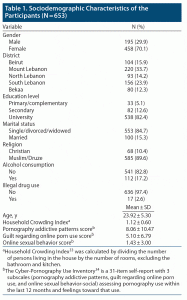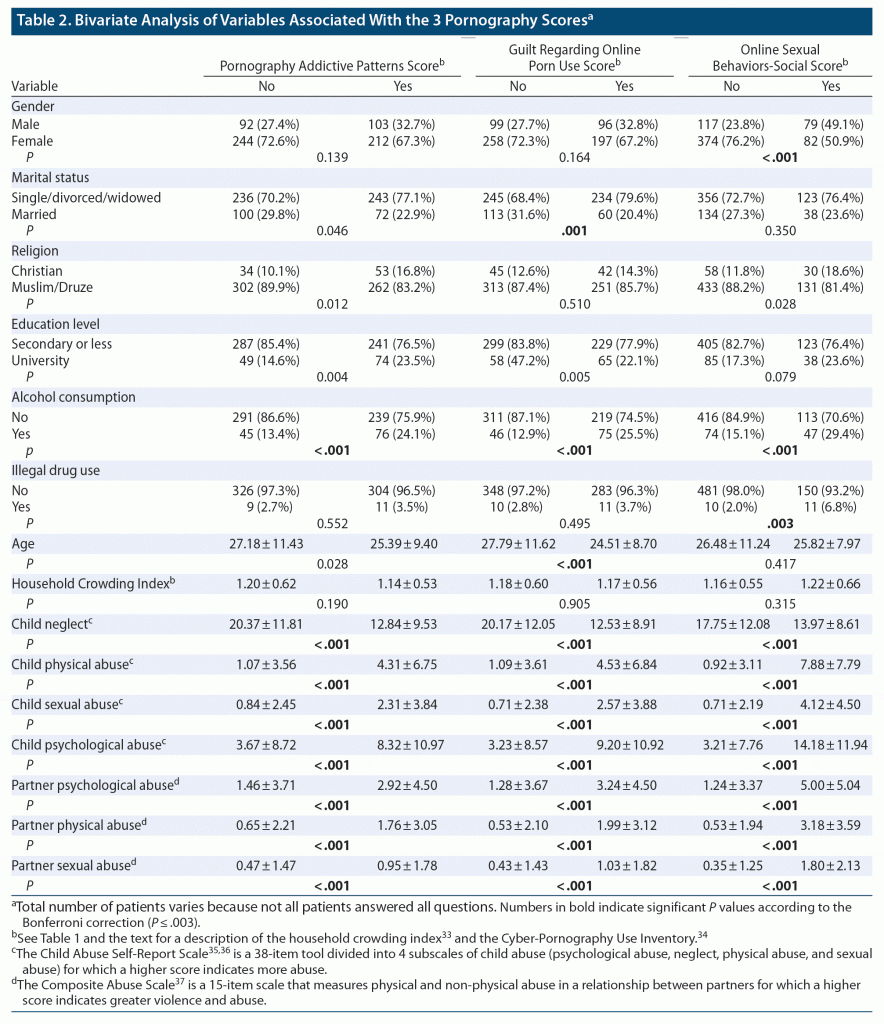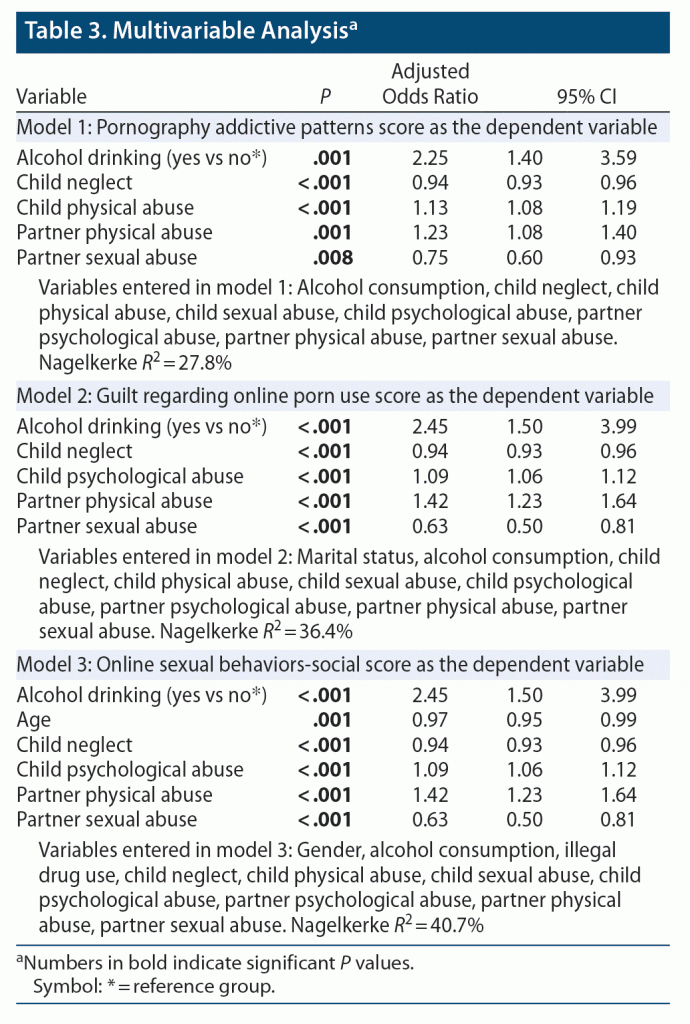ABSTRACT
Objective: To assess the association between child and intimate partner abuse and problematic pornography use among Lebanese adults.
Methods: This cross-sectional study conducted between October and November 2020 enrolled a total of 653 participants aged > 18 years from all Lebanese districts. The questionnaire was sent through various social media platforms such as WhatsApp, Facebook Messenger, and Instagram. The Cyber-Pornography Use Inventory assessed problematic pornography use, the Child Abuse Self-Report Scale assessed child abuse, and the Composite Abuse Scale evaluated partner abuse.
Results: The study findings highlighted that more child neglect and partner sexual abuse were associated with less odds of pornography addictive patterns, whereas alcohol consumption, higher child physical abuse, and higher partner physical abuse were significantly (P < .001) associated with higher odds of having pornography addictive patterns. Moreover, more partner sexual abuse and child neglect were significantly (P < .001) associated with less odds of having guilt regarding online porn use, whereas alcohol consumption, more partner physical abuse, and more child psychological abuse were significantly (P < .001) associated with more odds of having guilt regarding online porn use. Furthermore, higher age, more partner sexual abuse, and more child neglect were significantly (P < .001) associated with less odds of having online sexual behaviors-social, whereas alcohol consumption, more partner physical abuse, and more child psychological abuse were significantly (P < .001) associated with higher odds of having online sexual behaviors-social.
Conclusions: The study findings highlighted that pornography use is positively linked with child and partner abuse and alcohol consumption. Further investigation and research are recommended to properly assess problematic pornography use, develop appropriate treatment options, and evaluate mental health and sexual life effects.
Prim Care Companion CNS Disord 2023;25(2):21m03208
To cite: Malaeb D, Azzi V, Hallit S, et al. Assessment of problematic pornography use among Lebanese adults and the role of child and partner abuse. Prim Care Companion CNS Disord. 2023;25(2):21m03208.
To share: https://doi.org/10.4088/PCC.21m03208
© 2023 Physicians Postgraduate Press, Inc.
aCollege of Pharmacy, Gulf Medical University, Ajman, United Arab Emirates
bSchool of Pharmacy, Lebanese International University, Beirut, Lebanon
cSchool of Medicine and Medical Sciences, Holy Spirit University of Kaslik, Jounieh, Lebanon
dResearch Department, Psychiatric Hospital of the Cross, Jal Eddib, Lebanon
eApplied Science Research Center, Applied Science Private University, Amman, Jordan
fSocial and Education Sciences Department, School of Arts and Sciences, Lebanese American University, Jbeil, Lebanon
‡Last coauthors.
*Corresponding authors: Souheil Hallit, PharmD, MSc, MPH, PhD, School of Medicine and Medical Sciences, Holy Spirit University of Kaslik, PO Box 446, Jounieh, Lebanon ([email protected]) and Sahar Obeid, PhD, Social and Education Sciences Department, School of Arts and Sciences, Lebanese American University, Jbeil, Lebanon ([email protected]).
Internet addiction is one of many problematic addictive behaviors that has arisen during the digital technology era and includes specific applications found on the internet (eg, games, shopping, gambling, cybersex).1 The internet provides new outlets for recognized addicts and tempts those who have not previously been involved in such behaviors.2 Online pornography use might be one such internet behavior with a risk for addiction.2 Sexuality has undergone a new revolution,3 mostly attributed to the web and its pornographic content. Pornography is defined as “intentionally looking at pictures, videos, written and/or audio material, depicting naked portraits and/or people engaging sexually or masturbating.”4 Pornography is utilized worldwide as a means of entertainment and is referred to as fictional drama in printed or visual forms, depicting explicit sexual body parts or sexual activity. Use of pornographic material has increased due to the elements of anonymity, affordability, and accessibility, known as the “Triple A Model.”5
According to the US Department of Justice, federal law “prohibits the possession with intent to sell or distribute obscenity; to send, ship, or receive obscenity; to import obscenity; and to transport obscenity across state borders for purposes of distribution,” with convicted offenders facing fines and imprisonment.6 In many countries, pornography is permitted or some of its aspects are considered permitted while others are not.2 However, government policies in most countries are unable to keep up with the speed of the technological and social changes that converge with use of internet-based pornography.2
The use of pornography can be a contributing factor in crimes associated with the possession of illegal images of children.7–11 Since pornography viewing may increase the propensity of rape, violence, sexual assault, and online and sexual harassment, some authorities, such as the UK Parliament, have passed laws mandating legal pornographic websites to implement robust age verification checks.12 Other countries have hindered and limited various explicit sites that deal with child pornography issues.13
Recently, pornography use has increased given its easy accessibility, providing pictures, movies, lyrics, e-mails, chats, and webcams.5 Availability of websites at low or even no cost to users has also increased access. Although pornography use has not been qualified as a disease state, it can cause serious harm if sexual obsession predominates.14
Research has explored the role of different psychological processes and environmental risk factors in the development of sexual and cybersexual addictive-like behaviors. According to previous literature, online pornography-seeking behavior was related to poor caregiver-child relations, low caregiver monitoring, and higher forms of coercive discipline.15,16 In addition, physical and sexual victimization, delinquent behavior, increased substance abuse, and clinical features of depression trigger the development of problematic use of pornography.2
Previous research highlighted that child abuse alters anatomic and electrophysiologic functions, causing cognitive impairments that can influence future behavior.17 Such behavior included engaging in problematic pornography use.17 Child abuse in its different forms—neglect, physical abuse, psychological abuse, and sexual abuse—can lead to harm manifest in both physical and psychological consequences.18 Also, intimate partner abuse and violence, described as any physical, sexual, or psychological harm by a current or former partner or spouse, predicted a higher risk of excessive pornography use, as it impacts sexual satisfaction leading to increased sexual drive.19,20
Studies21,22 have indicated that users who watched pornography in the past year were mainly men or those with affective disorders. Other factors favoring pornography use included time at which pornography was encountered, area of residence, peer influence, and the preferred type of pornography.23,24 In addition to the previously mentioned variables, illegal drug use and alcohol consumption were associated with higher use of pornography, as they cause cognitive impairment and trigger participation in risky behaviors.25
Moreover, increased pornography use was associated with lower commitment to one’s partner and higher infidelity rates but was found to possibly exert a positive effect on romantic relationships if used as a couple.26 Also, religion was associated with reduced pornography use due to restrictions and rejection of extramarital sexual relationships.27
Pornography is a sensitive subject fraught with many misconceptions and moral biases in the Middle East and Arab countries. Lebanon, with its sociocultural and religious norms, views sexuality as a covert issue, and sexual discourse is highly discouraged.28 Therefore, due to religious restrictions in Arab countries such as Lebanon, sexuality is a prohibited topic, and knowledge is lacking compared to Western countries.29 To date, there has been a shortage of research in Lebanon concerning sexual behavior and sexual life perspectives and quality. Hence, this study aimed to assess the association between child and intimate partner abuse and problematic pornography use among Lebanese adults. We hypothesize that more childhood abuse (neglect, physical, sexual, psychological) and greater partner violence (psychological, physical, sexual) would be associated with more problematic pornography use.
METHODS
Participants
This cross-sectional study was conducted between October and November 2020 and enrolled participants from all Lebanese districts (Beirut, Mount Lebanon, North, South, and Bekaa). Data collection was based on an anonymous online questionnaire that reaches specific groups of individuals and allows nationwide research.30 The study’s anonymity was assured to eliminate the effect of embarrassment that may be associated with pornography use.31 The study included Lebanese adults aged > 18 years. Only completed questionnaires were analyzed. To reach the largest possible group of participants, invitations to complete the questionnaire were sent through various social media platforms such as WhatsApp, Facebook Messenger, and Instagram. Those who refused to complete the questionnaire were excluded from the study.32
Minimal Sample Size
Previous research33 found that males compared to females have higher online pornography use (8.76% versus 5.39%) with 95% confidence interval limits. Thus, the minimal sample size calculated was 123.
Questionnaire
Lebanese participants were asked to complete an anonymous questionnaire in their native language (Arabic) that required approximately 20 minutes. The first part of the questionnaire evaluated sociodemographic information such as age, gender, religion (Christian or Muslim), alcohol consumption, and illegal drug use. The Household Crowding Index was also calculated, dividing the number of persons living in the house by the number of rooms, excluding the bathroom and kitchen.34 The second part of the questionnaire comprised the scales described below.
Cyber-Pornography Use Inventory
The Cyber-Pornography Use Inventory35 is a 31-item self-report inventory comprised of 3 subscales. Most questions involve Likert scales ranging from strongly agree to strongly disagree (7 points) or from never to always (5 points).35 These subscales are as follows:
- Pornography addictive patterns score: 14 items assessing pornography addiction in the last 12 months. Questions are evaluated as follows: not at all, rarely, sometimes, often (Cronbach α = 0.905).35
- Guilt regarding online porn use score: 12 questions addressing negative emotions, feelings, and shame following online pornography use. Questions are evaluated as follows: never, rarely, sometimes, frequently, always (Cronbach α = 0.863).35
- Online sexual behavior-social score: 6 items evaluating the means of online sexual behavior, whether through messages, nicknames, chats, or sexual humor. The questions are evaluated as follows: never, rarely, sometimes, frequently, always (Cronbach α = 0.878).35
Child Abuse Self-Report Scale
The Child Abuse Self-Report Scale36 is a 38-item tool divided into 4 subscales of child abuse: psychological abuse (14 items), neglect (11 items), physical abuse (8 items), and sexual abuse (5 items). The scale is scored on a 4-point Likert scale (0 = never, 1 = sometimes, 2 = most often, 3 = always), with higher scores indicating more childhood abuse.36,37 The Cronbach α values for the different subscales were as follows: child neglect (0.968), physical abuse (0.937), sexual abuse (0.912), and psychological abuse (0.956).
Composite Abuse Scale
The Composite Abuse Scale38 measures physical and non-physical abuse in a relationship between partners. It comprises 15 items scored on a Likert scale (total score ≥ 7) ranging from 0 (not in the past 12 months) to 5 (daily/almost daily).38 The higher the ranking, the greater the violence/abuse between spouses/partners. The Cronbach α values for the subscales were as follows: psychological abuse (0.885), physical abuse (0.902), and sexual abuse (0.913).
Statistical Analysis
Data analysis was performed with SPSS software version 25. Weighting to the general population was done for gender and education level. The 3 scores (pornography addictive patterns score, guilt regarding online porn use, and online sexual behavior) did not follow a normal distribution via a calculation of the skewness and kurtosis; values for asymmetry and kurtosis were outside the acceptable range between −2 and +2 to prove normal univariate distribution.39 Scores were dichotomized according to their respective median values. In the bivariate analysis, the χ2 test was used to compare 2 categorical variables, whereas the Student t test was used to compare the means of 2 groups. The Bonferroni correction for multiple testing was applied. The corrected P value for significance in the bivariate analysis was estimated at .003; it was calculated by dividing .05 by the number of variables to be tested (15). Three logistic regressions were conducted, taking the pornography addictive patterns, guilt regarding online porn use, and online sexual behavior scores as dependent variables. To minimize residual confounding, independent variables entered in the final model were those that showed a P < .2 in the bivariate analysis.40 A P < .05 was considered significant.
RESULTS
Sociodemographic Characteristics
A total of 653 participants agreed to participate in the study. The mean ± SD age was 23.92 ± 5.30 years, with 70.1% females. Other descriptive details can be found in Table 1.
When dichotomizing the 3 scores according to their respective medians, the results showed that 375 (57.4%) participants had porn-addictive patterns and 329 (50.4%) had guilt regarding online porn use, whereas 189 (28.9%) had online sexual behaviors.
Bivariate Analysis
The results of the bivariate analysis are summarized in Table 2. A higher percentage of participants who consumed alcohol had porn-addictive patterns. While child neglect was lower in participants with porn-addictive patterns, child physical, sexual, and psychological abuse, as well as partner physical, sexual, and psychological abuse were significantly higher.
Single status; alcohol consumption; child physical, sexual, and psychological abuse; and partner physical, sexual, and psychological abuse were significantly associated with guilt regarding online porn use. However, those with guilt regarding online porn use had a lower mean age and less child neglect.
Finally, those with online sexual behaviors were more likely to be men, alcohol drinkers, and illegal drug users. Less child neglect but more child physical, sexual, and psychological abuse and partner physical, sexual, and psychological abuse were associated with engagement in online sexual behaviors.
Multivariable Analyses
Pornography addictive patterns. Partner sexual abuse (aOR=0.75) and child neglect (aOR=0.94) were significantly associated with less odds of having porn-addictive patterns, whereas alcohol consumption (aOR=2.25), child physical abuse (aOR=1.13), and partner physical abuse (aOR=1.23) were significantly associated with higher odds of having porn-addictive patterns (Table 3, Model 1).
Guilt regarding online porn use. Partner sexual abuse (aOR=0.63) and child neglect (aOR=0.94) were significantly associated with less odds of having guilt regarding online porn use, whereas alcohol consumption (aOR=2.45), partner physical abuse (aOR=1.42), and child psychological abuse (aOR=1.09) were significantly associated with higher odds of having guilt regarding online porn use (Table 3, Model 2).
Online sexual behaviors-social. Older age (aOR=0.97), partner sexual abuse (aOR=0.63), and child neglect (aOR=0.94) were significantly associated with less odds of having online sexual behaviors, whereas alcohol consumption (aOR=2.45), partner physical abuse (aOR=1.42), and child psychological abuse (aOR=1.09) were significantly associated with higher odds of having online sexual behaviors-social (Table 3, Model 3).
DISCUSSION
Child Abuse
This study highlighted that child physical and psychological abuse was significantly associated with higher porn-addictive patterns, online sexual behaviors, and guilt regarding online porn use, which was not thoroughly discussed in previous literature. However, previous findings concluded that childhood abuse might trigger psychiatric illness, which ultimately impacts social health and relationship development throughout adulthood.20 Thus, children who have been abused tend to have higher risk of self-harm and altered cognitive levels that may impact their adult behaviors including sexual acts.41,42 In addition, child sexual abuse characterized by exposure to abusive sexual behaviors at a young age contributes to ongoing risk behaviors such as pornography use.43
Partner Abuse
Our study highlighted that partner physical abuse was significantly associated with higher porn-addictive patterns, online sexual behaviors, and guilt regarding online porn use, which was not thoroughly discussed in previous literature. Previous findings supported that partner abuse (physical, emotional, verbal, or sexual) might increase sexual satisfaction and drive, explaining the higher rates of pornography consumption.20 Furthermore, partner sexual abuse and neglect are associated with sexual aggression and violence, which increases pornography viewing.44
Alcohol
Our study results showed that alcohol consumption was associated with higher problematic pornography use (pornography addictive patterns, guilt regarding online porn use, online sexual behaviors), consistent with the results of another research study.33 It has also been shown that alcohol consumption impairs cognitive function and abstracts reasoning and judgment, increasing engagement in risky behaviors such as pornography.45
Age
Our results showed that higher age was significantly associated with less odds of having online sexual behaviors, consistent with findings from other studies.45,46 It has been shown that pornography consumption and engagement in online sexual behaviors are lower in older individuals due to limited sexual interest and difficulty in comprehending and accessing the digital media to obtain sexual information.47
Implications for Practice
This study adds useful information regarding pornography use in Lebanon that is compatible with international findings concerning sex in general. Moreover, it allows for implementation of early interventional strategic steps to prevent child abuse and apply measures to raise awareness about pornography and its associated factors. Focusing on treating physically and sexually abused individuals while restraining illegal substance intake and alcohol consumption may help decrease pornography use. Furthermore, psychological and psychiatric support limits the factors that favor pornography and minimizes the risk of consumption.
Limitations
The study had several limitations. It used self-report measures in which some participants may have lied due to the topic’s sensitive nature33 despite assurance of anonymity. Thus, the study may be subject to both selection and information bias that confound our results, although potential confounding factors were accounted for in the statistical analysis. Another limitation is the uncertainty about whether the actual problematic pornography use, or participants’ suspicion of use, cause their psychological distress. This study did not consider the influence of mental health, which can confound the present findings. Our study also used some non-validated scales that may raise questions regarding the accuracy of generated results. Residual confounding bias may be possible, as not all factors related to online pornography use were considered in the study. However, the study’s intention and value reside in the data uniqueness and richness in depth and description.
CONCLUSION
This study aimed to assess different factors associated with problematic pornography use. The study findings highlight that pornography is positively linked with child physical and psychological abuse, partner physical abuse, and alcohol consumption. Further research is recommended to properly assess problematic pornography use, develop appropriate treatment options, and evaluate mental health and sexual life effects.
Submitted: December 4, 2021; accepted March 16, 2022.
Published online: March 2, 2023.
Relevant financial relationships: None.
Funding/support: None.
Additional information: All data generated or analyzed during this study are not publicly available to maintain the privacy of the individuals’ identities. The dataset supporting the conclusions is available upon request from the corresponding author.
Clinical Points
- Pornography use was positively linked with child and partner abuse.
- Pornography use was associated with more alcohol consumption.
- Further research is recommended to properly assess problematic pornography use, develop appropriate treatment options, and evaluate mental health and sexual life effects.
References (47)

- Davis RA. A cognitive-behavioral model of pathological Internet use. Comput Human Behav. 2001;17(2):187–195. CrossRef
- de Alarcón R, de la Iglesia JI, Casado NM, et al. Online porn addiction: what we know and what we don’t: a systematic review. J Clin Med. 2019;8(1):91. PubMed CrossRef
- Huang Y. Sexuality and everydayness in a transnational context: toward a re-imagined West-China relationship? Cult Health Sex. 2017;19(6):667–679. PubMed CrossRef
- Peter J, Valkenburg PM. Adolescents and pornography: a review of 20 years of research. J Sex Res. 2016;53(4-5):509–531. PubMed CrossRef
- Mead D, Sharpe M. Aligning the “Manifesto for a European Research Network into problematic usage of the internet” with the diverse needs of the professional and consumer communities affected by problematic usage of pornography. Int J Environ Res Public Health. 2020;17(10):3462. PubMed CrossRef
- The United States Department of Justice. Citizen’s Guide to US Federal Law on Obscenity. Accessed January 12, 2023. https://www.justice.gov/criminal-ceos/citizens-guide-us-federal-law-obscenity#:~:text=Federal%20law%20prohibits%20the%20possession,borders%20for%20purposes%20of%20distribution
- Merdian HL, Wilson N, Thakker J, et al. So why did you do it?”: explanations provided by child pornography offenders. Sex Offender Treatment. 2013;8(1):1–19.
- Fortin F, Proulx J. Sexual interests of Child Sexual Exploitation Material (CSEM) Consumers: four patterns of severity over time. Int J Offender Ther Comp Criminol. 2019;63(1):55–76. PubMed CrossRef
- Saramago MA, Cardoso J, Leal I. Pornography use by sex offenders at the time of the index offense: characterization and predictors. J Sex Marital Ther. 2019;45(6):473–487. PubMed CrossRef
- Knack N, Holmes D, Fedoroff JP. Motivational pathways underlying the onset and maintenance of viewing child pornography on the internet. Behav Sci Law. 2020;38(2):100–116. PubMed CrossRef
- Harvey TA, Jeglic EL. Attenuation of deviant sexual fantasy across the lifespan in United States adult males. Psychiatry Psychol Law. 2020;27(2):246–264. PubMed CrossRef
- Thurman N, Obster F. The regulation of internet pornography: What a survey of under‐18s tells us about the necessity for and potential efficacy of emerging legislative approaches. Policy Internet. 2021;13(3):415–432. CrossRef
- Salian D, Khatun S. Legal Framework on Child Pornography: A Perspective. Digital Forensic Science. IntechOpen website. https://www.intechopen.com/chapters/72331. 2020.
- Sassover E, Weinstein A. Should compulsive sexual behavior (CSB) be considered as a behavioral addiction? a debate paper presenting the opposing view. J Behav Addict. 2020;11(2):166–179. PubMed CrossRef
- Habesha T, Aderaw Z, Lakew S. Assessment of exposure to sexually explicit materials and factors associated with exposure among preparatory school youths in Hawassa City, Southern Ethiopia: a cross-sectional institution based survey. Reprod Health. 2015;12(1):86. PubMed CrossRef
- Schenk CB. Pornography as a leisure behavior: an investigation of pornography use and leisure boredom. BYU website. https://scholarsarchive.byu.edu/etd/1976/. 2009.
- Petersen AC, Joseph J, Feit M. Committee on Law and Justice, National Research Council. Consequences of child abuse and neglect. New Directions in Child Abuse and Neglect Research. National Academies Press (US); 2014.
- Gonzalez D, Mirabal AB, McCall JD. Child Abuse and Neglect. StatPearls; 2021. ([Internet])
- Beymer MR, Hill CG, Perry MA, et al. Pornography use and intimate partner violence among a sample of US Army soldiers in 2018: a cross-sectional study. Arch Sex Behav. 2021;50(5):2245–2257. PubMed CrossRef
- Slim M, Haddad C, Sfeir E, et al. Factors influencing women’s sex work in a Lebanese sample: results of a case-control study. BMC Womens Health. 2020;20(1):193. PubMed CrossRef
- Grubbs JB, Kraus SW, Perry SL. Self-reported addiction to pornography in a nationally representative sample: the roles of use habits, religiousness, and moral incongruence. J Behav Addict. 2019;8(1):88–93. PubMed CrossRef
- Rissel C, Richters J, de Visser RO, et al. A profile of pornography users in Australia: findings from the second Australian study of health and relationships. J Sex Res. 2017;54(2):227–240. PubMed CrossRef
- Braithwaite S, Aaron S, Dowdle K, et al. Does pornography consumption increase participation in friends with benefits relationships? Sex Cult. 2015;19:513–532. CrossRef
- Chowdhury MRHK, Chowdhury MRK, Kabir R, et al. Does the addiction in online pornography affect the behavioral pattern of undergrad private university students in Bangladesh? Int J Health Sci (Qassim). 2018;12(3):67–74. PubMed
- Woldeamanuel BT, Anteneh LM, Yohannes YB, et al. Assessment of exposure to sexually explicit materials and substance abuse among high-school adolescents in North Shewa Zone: application of logistic regression analysis. J Addict. 2020:8105087. PubMed CrossRef
- Minarcik J, Wetterneck CT, Short MB. The effects of sexually explicit material use on romantic relationship dynamics. J Behav Addict. 2016;5(4):700–707. PubMed CrossRef
- Maas MK, Vasilenko SA, Willoughby BJ. A dyadic approach to pornography use and relationship satisfaction among heterosexual couples: the role of pornography acceptance and anxious attachment. J Sex Res. 2018;55(6):772–782. PubMed CrossRef
- Gesser-Edelsburg A, Abed Elhadi Arabia M. Discourse on exposure to pornography content online between Arab adolescents and parents: qualitative study on its impact on sexual education and behavior. J Med Internet Res. 2018;20(10):e11667. PubMed CrossRef
- Ahsan MS, Arafat SM, Rahman SM, et al. Sexual history taking competency: a survey among the clinicians in Bangladesh. Int J Psychiatry. 2016;1:4.
- Rzymski P, Jaśkiewicz M. Microalgal food supplements from the perspective of Polish consumers: patterns of use, adverse events, and beneficial effects. J Appl Phycol. 2017;29(4):1841–1850. PubMed CrossRef
- Gilliland R, South M, Carpenter B, et al. The roles of shame and guilt in hypersexual behavior. Sex Addict Compulsivity. 2011;18(1):12–29. CrossRef
- Sfeir E, Malaeb D, Hallit S, et al. Personality traits and online pornography use among Lebanese adults. Prim Care Companion CNS Disord. 2022;24(6):22m03131. PubMed CrossRef
- Harper C, Hodgins DC. Examining correlates of problematic internet pornography use among university students. J Behav Addict. 2016;5(2):179–191. PubMed CrossRef
- Melki IS, Beydoun HA, Khogali M, et al; National Collaborative Perinatal Neonatal Network (NCPNN). Household crowding index: a correlate of socioeconomic status and inter-pregnancy spacing in an urban setting. J Epidemiol Community Health. 2004;58(6):476–480. PubMed CrossRef
- Grubbs JB, Sessoms J, Wheeler DM, et al. The Cyber-Pornography Use Inventory: the development of a new assessment instrument. Sex Addict Compulsivity. 2010;17(2):106–126. CrossRef
- Mohammadi M-R. Development, validation and reliability of Child Abuse Self-Report Scale (CASRS) in Iranian students. Med J Islam Repub Iran. 2003;17:51–58.
- Fekih-Romdhane F, Dabbous M, Hallit R, et al. Development and validation of a shortened version of the Child Abuse Self-Report Scale (CASRS-12) in the Arabic language. Child Adolesc Psychiatry Ment Health. 2022;16(1):100. PubMed CrossRef
- Ford-Gilboe M, Wathen CN, Varcoe C, et al. Development of a brief measure of intimate partner violence experiences: the Composite Abuse Scale (Revised)-Short Form (CASR-SF). BMJ Open. 2016;6(12):e012824. PubMed CrossRef
- George D. SPSS for Windows Step by Step: A Simple Study Guide and Reference, 17.0 Update, 10/e. Pearson Education India; 2011.
- Bursac Z, Gauss CH, Williams DK, et al. Purposeful selection of variables in logistic regression. Source Code Biol Med. 2008;3:17. PubMed CrossRef
- Edwards D. Childhood sexual abuse and brain development: a discussion of associated structural changes and negative psychological outcomes. Child Abuse Rev. 2018;27(3):198–208. CrossRef
- Konopka LM. The impact of child abuse: neuroscience perspective. Croat Med J. 2015;56(3):315–316. PubMed CrossRef
- Rostad WL, Gittins-Stone D, Huntington C, et al. The association between exposure to violent pornography and teen dating violence in grade 10 high school students. Arch Sex Behav. 2019;48(7):2137–2147. PubMed CrossRef
- Rothman EF, Adhia A. Adolescent pornography use and dating violence among a sample of primarily Black and Hispanic, urban-residing, underage youth. Behav Sci (Basel). 2015;6(1):1. PubMed CrossRef
- Farré JM, Montejo AL, Agulló M, et al. Pornography use in adolescents and its clinical implications. J Clin Med. 2020;9(11):3625. PubMed CrossRef
- Rothman EF, Beckmeyer JJ, Herbenick D, et al. The prevalence of using pornography for information about how to have sex: findings from a Nationally Representative Survey of US adolescents and young adults. Arch Sex Behav. 2021;50(2):629–646. PubMed CrossRef
- Simon L, Daneback K. Adolescents’ use of the internet for sex education: a thematic and critical review of the literature. Int J Sex Health. 2013;25(4):305–319. CrossRef
Please sign in or purchase this PDF for $40.








